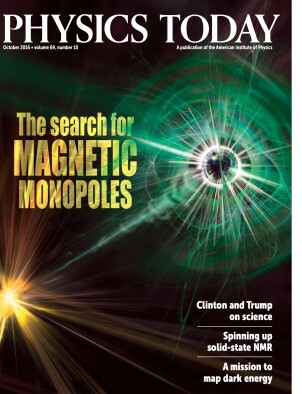Sterile neutrinos give IceCube and other experiments the cold shoulder
DOI: 10.1063/PT.3.3316
Under kilometers of ice at the South Pole, the IceCube Neutrino Observatory’s 5160 optical detectors keep watch for neutrinos that have traveled through Earth from the opposite side of the globe. (See the article by Francis Halzen and Spencer R. Klein, Physics Today, May 2008, page 29

Figure 1. The IceCube Laboratory sits under the serene glow of the aurora australis at the South Pole. Kilometers below the Antarctic ice, 5160 photodetectors watch for Cherenkov light from charged particles that are produced when atmospheric neutrinos collide with nuclei in the bedrock or ice. (Photo by Ian Rees, IceCube/NSF.)
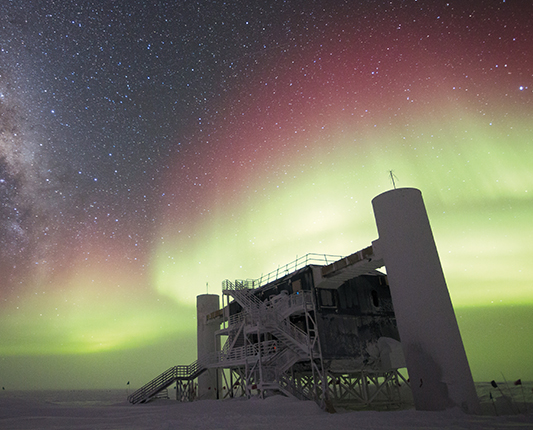
The standard model of particle physics posits the existence of three flavors of neutrinos. Among IceCube’s many scientific quarries are signs that some of the atmospheric neutrinos, during their transit through Earth, transform into sterile neutrinos—hypothetical particles that interact with other matter only via gravity. A recent analysis of 20 145 high-energy atmospheric neutrino events from 2011–12 has yielded no such sign. 1
Meanwhile, researchers from MINOS (Main Injector Neutrino Oscillation Search) and the Daya Bay Reactor Neutrino Experiment recently joined forces. MINOS is an accelerator-neutrino experiment at Fermilab; Daya Bay is a reactor-based experiment in South China. When the joint collaboration analyzed data from the two experiments, along with data from a third source, the Bugey-3 reactor-neutrino experiment in France, the researchers, too, found no evidence for sterile neutrinos. 2
Although the results don’t rule out sterile neutrinos, they do place stringent limits on how a possible sterile neutrino might mix with the three well-established ones. In so doing, they heighten the tension between a handful of experiments that have tantalizingly hinted at an unseen sterile neutrino and those that are perfectly compatible with the usual three flavors: electron, muon, and tau.
The sterile hypothesis
Neutrino flavors, which are eigenstates of the weak interaction, are quantum mechanical superpositions of mass eigenstates. Because the mass eigenstates have different masses, each one propagates differently. Thus a neutrino born as one superposition, after propagating some distance, can evolve into a different superposition. The flavor- and mass-eigenstate bases are related by the unitary transformation
Neutrino-oscillation experiments come in two varieties: those that track the disappearance of a particular neutrino flavor while in transit and those that detect the appearance of a neutrino flavor that wasn’t present at the source. In the 1990s the appearance-type LSND (Liquid Scintillator Neutrino Detector) experiment at Los Alamos National Laboratory set out to look for electron antineutrinos (
In 1995 the LSND team reported finding excess numbers of
Light sterile neutrinos of the kind implied by LSND were unanticipated. In its simplest form, the leading theoretical treatment of sterile neutrino flavors, called the seesaw model, invokes three TeV-mass-range sterile neutrinos—one partnered with each known neutrino—whose decay properties can account for the matter–antimatter imbalance in the universe. Another idea proposes a keV-mass sterile neutrino as a dark-matter candidate. “There’s not a whole bunch of theoretical models that scream that these light sterile neutrinos need to exist,” explains Fermilab theorist Boris Kayser. Thus, he says, searches for light sterile neutrinos have been driven largely by experimental hints.
Those hints emerged from the LSND experiment, but they didn’t stop there. MiniBooNE, an accelerator experiment at Fermilab, first discounted the LSND results, but then reopened the account when additional measurements showed that the
Recent improvements in models of
Also in the 1990s, Gallex (short for Gallium Experiment) at Italy’s Gran Sasso National Laboratory and SAGE (Soviet-American Gallium Experiment) at the Baksan Neutrino Observatory in Russia used radioactive chromium-51 (and later argon-37 at SAGE) as a
Lamppost in the desert
IceCube’s principal investigator, Francis Halzen (University of Wisconsin–Madison), says that the space of mass-squared differences and mixing angles that could support a putative sterile neutrino is like an infinite desert at night. “Twenty years ago,” he says, “the LSND experiment put a lamppost in this desert of parameters.”
As fortune would have it, IceCube is well suited to test the LSND anomaly. At neutrino energies of 320 GeV–20 TeV, the range that the IceCube researchers analyzed for their sterile search, interactions with matter can resonantly enhance neutrino oscillation. “And it turns out that if you throw in a sterile neutrino, everything changes,” says Halzen.
The IceCube collaboration considered the simplest possible model, one with the three known neutrinos and one sterile neutrino of eV-range mass. For such a model, IceCube’s detectors should see
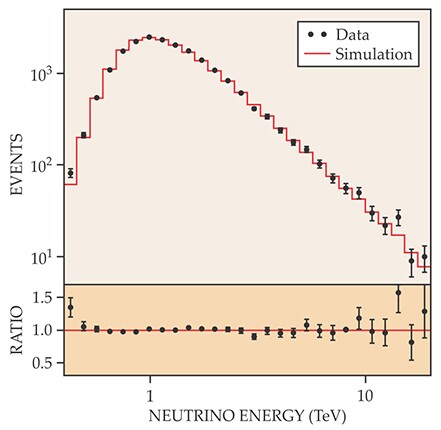
Figure 2. IceCube energy spectrum. The number of observed atmospheric muon neutrinos compared with a Monte Carlo simulation that assumes no sterile neutrinos. The lower panel shows the ratio of observed to simulated events. If oscillations into sterile neutrinos with a mass of 1 eV were present, a dip in the spectrum would appear at a neutrino energy of 3 TeV. (Adapted from ref.
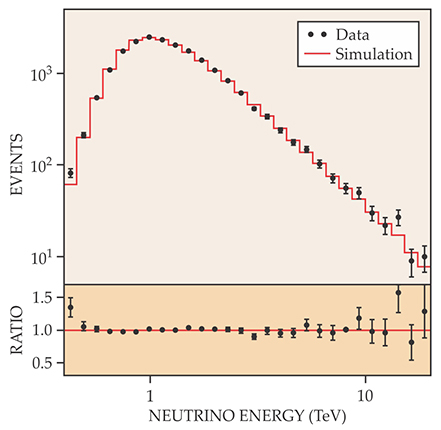
As shown in figure 3a, the results appear to rule out the region of parameter space consistent with the LSND and MiniBooNE observations. An independent analysis of publicly available IceCube data by Jiajun Liao and Danny Marfatia, both at the University of Hawaii, at Manoa, drew similar exclusions. 3 However, Liao and Marfatia caution that if nonstandard neutrino–matter interactions are sufficiently large, the limits might be evaded. Halzen concedes that more complex models could circumvent the IceCube limits, but he isn’t impressed. If ways around the limits can be conceived, Halzen says, it just means “now it’s the Wild West.”
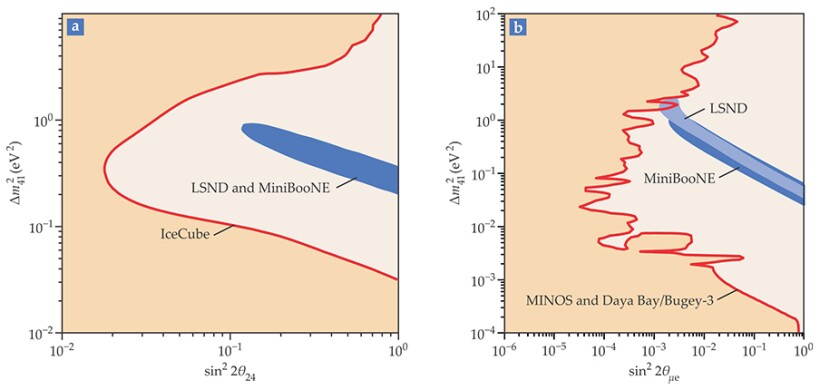
Figure 3. The simplest extension of the standard three-neutrino picture adds one sterile flavor state and thus a fourth mass eigenstate. (a) Based on that extension, an analysis of atmospheric muon neutrino observations by the IceCube Neutrino Observatory excludes the unshaded region of parameter space to the right of the red line at a 90% confidence level. That exclusion is in conflict with the allowed region for sterile neutrinos from a combined fit of LSND (Liquid Scintillator Neutrino Detector) and MiniBooNE experiments (dark blue). (Adapted from ref.
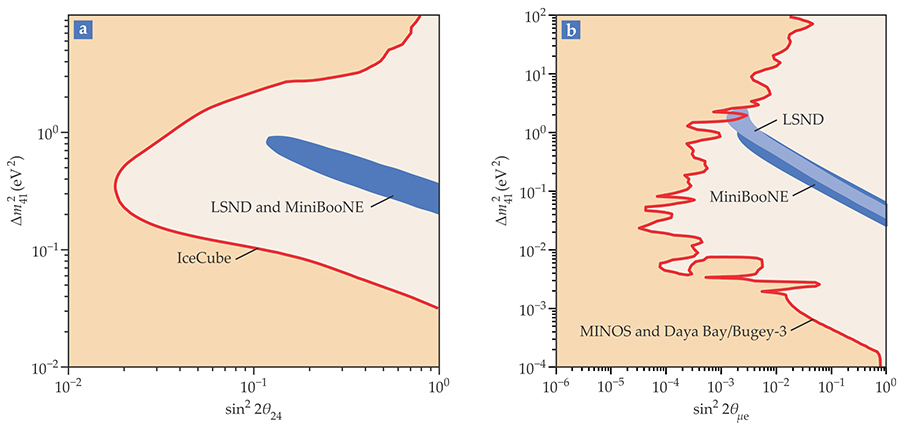
More no news
The MINOS experiment tracked neutrino disappearance by comparing the
Daya Bay monitors electron antineutrinos that originate from six nuclear reactors at the eponymous reactor complex in China’s Guangdong province. The reactor cores are located 300 m to 2 km from the experiment’s eight liquid-scintillator detectors. The presence of sterile neutrinos would distort the
Like IceCube’s analysis, the one by the MINOS–Daya Bay team also considered one sterile flavor and one additional mass eigenstate. And again, the results appear to exclude the portion of parameter space allowed by LSND and MiniBooNE, as shown in figure 3b.
Missing but not gone
Now that IceCube and MINOS–Daya Bay appear to have removed what Halzen calls the LSND lamppost, what’s to be done? As MIT’s Janet Conrad, a member of the IceCube collaboration, points out, “Disappearance experiments also have anomalies.” Including the gallium and reactor antineutrino anomalies and the new IceCube results in global fits of existing oscillation data tends to shift allowed regions to greater
The quest continues. Several planned experiments—the Precision Oscillation and Spectrum Experiment at Oak Ridge National Laboratory, the Detector of Anti-Neutrino based on Solid Scintillator project at the Kalinin Nuclear Power Plant in Russia, and the Stereo experiment at the Institut Laue–Langevin in France—aim to suss out the reactor antineutrino anomaly. At Fermilab, the Short-Baseline Neutrino Program to search for sterile neutrinos will have a complement of three detectors—Imaging Cosmic and Rare Underground Signals detector, MicroBooNE, and the Short-Baseline Near Detector—to monitor an accelerator neutrino source (see Physics Today, July 2015, page 23
References
1. M. G. Aartsen et al. (IceCube collaboration), Phys. Rev. Lett. 117, 071801 (2016). https://doi.org/10.1103/PhysRevLett.117.071801
2. P. Adamson et al. (Daya Bay, MINOS collaborations), Phys. Rev. Lett. (in press).
3. J. Liao, D. Marfatia, Phys. Rev. Lett. 117, 071802 (2016). https://doi.org/10.1103/PhysRevLett.117.071802
